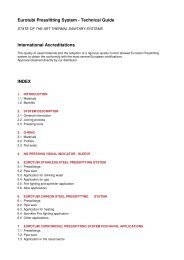corrosion of stainless steel - Damstahl
corrosion of stainless steel - Damstahl
corrosion of stainless steel - Damstahl
Create successful ePaper yourself
Turn your PDF publications into a flip-book with our unique Google optimized e-Paper software.
Chapter 6 - Corrosion <strong>of</strong> Stainless Steel<br />
Figure 6.19:<br />
Crevice <strong>corrosion</strong> in a welding nipple <strong>of</strong> 4404 exposed to an aqueous<br />
solution <strong>of</strong> copper chloride (CuCl 2<br />
). Note that the <strong>corrosion</strong> is concentrated<br />
in the seal track.<br />
Crevices are<br />
breeding<br />
grounds for<br />
microorganisms<br />
6.3.1 Microbially Induced Corrosion (MIC)<br />
An, if possible, even more unpredictable aspect <strong>of</strong> this is the occurrence <strong>of</strong><br />
microorganisms. Bitter experience tells us that microorganisms can affect<br />
the <strong>corrosion</strong> <strong>of</strong> <strong>stainless</strong> <strong>steel</strong> in very unfortunate ways - partly by forming<br />
actual fouling which can act as crevices and partly by creating a biolayer<br />
which changes the environment locally.<br />
One <strong>of</strong> the measurable effects <strong>of</strong> certain types <strong>of</strong> bacteria is that they can<br />
increase the <strong>corrosion</strong> potential <strong>of</strong> the <strong>steel</strong> to levels far above what is usually<br />
seen in pure tap water (typically 150-300 mV SCE<br />
in tap water; more than<br />
400 mV in purified waste water – see Figure 6.20). The result is that the<br />
CPT curves in Figure 6.10 are pushed radically downwards, and conditions<br />
thereby become far worse for the <strong>steel</strong>.<br />
In addition, the existing crevices will be better than the free surfaces at<br />
acting as fertile ground for microorganisms which is why microbially active<br />
environments will <strong>of</strong>ten make the <strong>steel</strong> far more sensitive to crevice <strong>corrosion</strong><br />
than to pitting <strong>corrosion</strong>. As described above, there is usually a temperature<br />
difference between crevice <strong>corrosion</strong> and pitting <strong>corrosion</strong> <strong>of</strong> 20-25°C (see<br />
Figure 6.18), but in microbiologically active media this temperature difference<br />
may become far greater. Examples are known particularly from sewage plants<br />
where acid-resistant 4404 has been attacked by severe crevice <strong>corrosion</strong> in<br />
cold water <strong>of</strong> 12-15°C but with less than 100 mg/l chloride, although the<br />
curves say that CPT should be well over 100°C. If so, one should expect<br />
crevice <strong>corrosion</strong> to be a problem at temperatures above 80°C, however, it<br />
sometimes occurs at far lower temperatures.<br />
103<br />
RS for alle.indb 103<br />
9/29/2011 12:44:40 PM

















